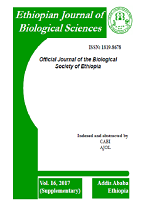STUDIES OF LARGE AND SMALL BARBS (GENUS BARBUS SENSU LATO; CYPRINIDAE; PISCES) CARRIED OUT BY FRESHWATER BIOLOGY GROUP OF JOINT ETHIO-RUSSIAN BIOLOGICAL EXPEDITION (JERBE)
Abstract
Surveys performed in all six main river basins of Ethiopia enabled describing fish species composition and distribution. One of the important results was discovery of ―species flocks‖ (aggregations of sympatric forms) of large African barbs in several rivers whereas earlier the only such ―species flock‖ was known from Lake Tana. In each flock there are generalized and specialized forms which differ in appearance, skull characters, and feeding habits. In a long term experiment, it was shown that both external traits and skull characters of the barbs change under influence of environmental conditions. Among progeny of specialized forms of the Lake Tana barbs, some individuals reared in aquaria were indistinguishable from the generalized form even at age of 5 years. In the coastal zone of Lake Tana, morphologically distinct groups of large barbs were found that cannot be affiliated with nominal species described from the lake. Absence of post-mating reproductive isolation between different forms (morphotypes) of the Lake Tana barbs was shown. Small barbs of Ethiopia are phylogenetically distant from large barbs. Judging from their morphology, small barbs include several distant phylogenetic lineages. The lineage of small barbs with serrated spine in the dorsal fin exhibit a noticeable evolution pattern of the parallel reduction of spine in uppermost parts of the three isolated river drainages. Molecular phylogenetic studies are needed to clarify taxonomy and relationships of most populations of small barbs found in the country.
Downloads
References
Berrebi, P. and Valiushok, D. (1998). Genetic divergence among morphotypes of Lake Tana (Ethiopia) barbs. Biol. J. Linn. Soc. 64(3): 369−384.
Beshera, K.A. and Harris, P.M. (2014). Mitochondrial DNA phylogeography of the Labeobarbus intermedius complex (Pisces, Cyprinidae) from Ethiopia. J. Fish Biol. 85: 228−245.
Boulenger, G.A. (1902). Description of new fishes from collection made by Mr. E. Degen in Abyssinia. Ann. Mag. Nat. Hist. (Ser. 7) 10: 421−437.
Boulenger, G.A. (1906). On a collection of fishes from Gallaland. Ann. Mag. Nat. Hist. (Ser. 7) 17: 557−566.
Boulenger, G.A. (1911). Catalogue of the Freshwater Fishes of Africa in the British Museum (Natural History), Vol. 2. Trustees, London.
de Graaf, M., Eshete Dejen, Sibbing, F.A. and Osse, J.W.M. (2000). Barbus tanapelagius, a new species from Lake Tana (Ethiopia): its morphology and ecology. Environ. Biol. Fish. 59: 1−9.
de Graaf, M., Eshete Dejen, Osse, J.W.M. and Sibbing, F.A. (2008). Adaptive radiation of Lake Tana‘s (Ethiopia) Labeobarbus species flock (Pisces, Cyprinidae). Mar. Freshwater Res. 59: 391−407.
de Graaf, M., Megens, H.-J., Samallo, J. and Sibbing, F. (2010). Preliminary insight into the age and origin of the Labeobarbus fish species flock from Lake Tana (Ethiopia) using the mtDNA cytochrome b gene. Mol. Phylogenet. Evol. 54: 336−343.
Demeke Admassu and Elias Dadebo (1997). Diet composition, length-weight relationship and condition factor of Barbus species Rüppell, 1836 (Pisces: Cyprinidae) in Lake Awassa, Ethiopia. SINET: Ethiop. J. Sci. 20: 13−30.
More inside the PDF
